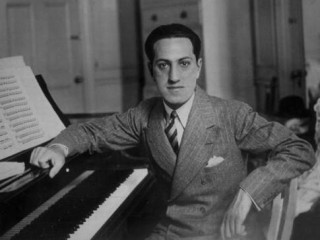
George Gershwin biography
Date of birth : 1898-08-26
Date of death : 1937-07-11
Birthplace : Brooklyn, New York, U.S.
Nationality : American
Category : Famous Figures
Last modified : 2011-05-17
Credited as : Composer, popular music, Lady Be Good, Primrose
American composer George Gershwin was eminently successful in popular music, as well as in the classical field with several concert works and an opera that have become standards in the contemporary repertory.
George Gershwin played a prominent role in one of the most colorful eras of American popular music: the so-called age of Tin Pan Alley—roughly 1890-1930—when popular music became big business. In Tin Pan Alley (28th Street between Broadway and Fifth Avenue in New York City) numerous music publishing houses poured forth popular songs each year. The musical theater and the private parlor rang with the sounds of ragtime, romantic ballads, and comedy songs. Talented composers such as Gershwin, Irving Berlin, and Jerome Kern, among dozens of lesser figures, fed this lucrative music-making machine and flourished.
George Gershwin was born in Brooklyn in New York City on Sept. 26, 1898, the son of Rose and Morris Gershovitz, immigrants from Russia. After settling in New York's Lower East Side, his father changed the family name to Gershvin; when George entered the professional world of music, he altered the name to Gershwin.
When George was 12, the moderately well-off family purchased a piano; he soon showed a marked inclination for improvising melodies and was given piano lessons. Later he studied the theory of music and harmony. Though Gershwin was not interested in formal education and never finished high school, he continued to study music. Even after his success in musical comedy, he studied with composer Henry Cowell and with music theorist Joseph Schillinger.
When Gershwin was 15, he went to work for a large publisher of popular music as a try-out pianist (or "song plugger"). He began writing his own songs about this time (mostly with lyricist Irving Caesar), none of which his employer was interested in publishing. Finally, in 1916, his first song appeared: "When You Want 'Em You Can't Get 'Em."
Gershwin also began to get a few songs set into current musical shows, a common practice of the day. By 1918 he had shown enough promise to be hired by Harms, Inc., as a songwriter at a weekly salary. Gershwin scored his first big success in 1919 with the song "Swanee" (words by Irving Caesar), introduced by Al Jolson in Sinbad. In the same year he composed his first complete score, for the successful musical La, La, Lucille.
During the 1920s Gershwin established himself as one of the musical theater's most talented and successful composers. He wrote five scores for successive editions of George White's Scandals (1920-1924) and began a series of shows with his brother, Ira, as lyricist, which included Lady Be Good (1924), Primrose (1924), Tell Me More (1925), Tip Toes (1925), Oh Kay (1926), Funny Face (1927), Rosalie (1928), Treasure Girl (1928), Show Girl (1929), and Strike Up the Band (1929).
In 1924 the prominent bandleader Paul Whiteman asked Gershwin to write an original "jazz" work for a concert. The result, Rhapsody in Blue for piano and jazz band, was Gershwin's debut in the concert hall as pianist and composer, his first attempt at writing an extended piece, and the first time jazz rhythms and blues-oriented melodies were used successfully within a classical framework.
Reviewing the premiere, Olin Downes wrote that the "composition shows extraordinary talent, just as it also shows a young composer with aims that go far beyond those of his ilk…." These aims were demonstrated again in the Piano Concerto in F (1925), commissioned by Walter Damrosch for his New York Symphony; Three Preludes for piano (1926); and An American in Paris (1928), premiered by Damrosch and the New York Philharmonic. After Rhapsody in Blue, Gershwin himself scored all his orchestral works.
In the 1930s Gershwin composed four more musicals with Ira: Girl Crazy (1930); Of Thee I Sing (1931), which was the first musical awarded a Pulitzer Prize; Let 'Em Eat Cake (1933); and Pardon My English (1933). He also wrote film scores, including Damsel in Distress and Shall We Dance. He spent 2 years on his last major work, the opera Porgy and Bess (1935), based on a novel by DuBose Heyward about a ghetto in Charleston, S. C. The composer died of a brain tumor in Beverly Hills, Calif., on July 11, 1937.
Gershwin's best songs have proved to be some of the most durable of his era, and his classical works give his career a dimension shared by none of his Tin Pan Alley companions. His fondness for African American music is responsible in part for the rhythmic vitality and blues-tinged lyricism of all his works. His best scores, especially those utilizing Ira Gershwin's trenchant and sympathetic verses, are as fresh, vigorous, and unconventional as any written for the American musical theater. Moreover, Gershwin's music has a peculiar American stamp recognized the world over.
















